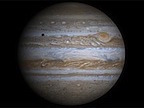You are here
Preface
As a child growing up in rural southern New Hampshire, I enjoyed climbing trees and exploring the woods behind my house with my brothers. Through this experience, I developed a deep sense of connection with the non-human natural world. I first acquired a special interest in astronomy around the age of 5, after I broke my right arm and was confined to a crib for a few months. My parents gave me a sticker book of astronomy to pass the time, and the pictures of the moon, planets, and other celestial phenomena helped me escape my confinement, and connect with a much larger world beyond the living room window. I recall deciding that I no longer wanted to be the coal deliveryman when I grew up, but would instead become an astronaut.
An interest in philosophy and religion similarly stems from childhood. My family attended a local Congregational Church, where the emphasis in the early years was "Jesus loves me." As a young teenager there, I was deeply influenced by a minister who was quite liberal. In particular, he believed that reason and logic are important to religious understanding, and interpreted scripture more metaphorically than literally.
In high school, I developed a keen interest in formal science, and set my sights on becoming a professional astronomer. I subsequently studied physics and astronomy as an undergraduate at Rensselaer Polytechnic Institute in upstate New York from 1967 through 1971, when I also developed a passion for physics, and came to enjoy reading science fiction. I moved on to graduate work in physics at Yale University, where I received a PhD in 1975. Because of the otherwise bleak job market at the time, I soon changed career path, into medical physics. I have been employed as a physicist in therapeutic radiology since 1980.
During the last several years of my formal education, many members of my family began moving from mainstream Protestantism into fundamentalist Christianity. The resulting schism generated significant internal tension. I soon endeavored to develop a rational philosophy and religion that made sense to me, while pursuing a career in physics.
The original motivation for The I of the Storm was in fact to showcase a philosophical/religious system that I developed as a young adult, called ideobasism. After failing to publish a nonfiction academic treatise on the subject, I decided to incorporate ideobasism into a work of fiction, in the guise of an alien belief system. The associated story soon took on a life of its own. I have been working erratically on the manuscript, under a variety of titles, for a good part of my adult life.
According to the dominant religion of the octan civilization in the story that follows, the universe is primarily the self-conscious realization of all possible consistent entities, which wills itself into existence out of sheer logical necessity. Other entities also exist, but are peripheral to this central Being. In the octan view, our own physical universe is a subset of a subset of all consistent mathematical objects within the greater body of consistent realities.
Supportive technical material concerning octan life and civilization is provided in appendices following the main story. I encourage interested readers to review Appendix E, and follow the arguments (as presented by the fictional ancient octan philosopher Fleegello) leading to ideobasism. The relationship between physics and octan philosophy is examined (again, through the eyes of Fleegello) in Appendix F. Non-fictional commentary and references are provided as addenda to the main appendices.
Our universe is likely far stranger, more complex, yet simpler than humans can know. Confined until recently to the thin skin of a rocky planet blessed with plentiful liquid water, human imaginings of what life can be have been largely tethered to carbon-based structures and aqueous chemistries. This is understandable, since scientific inquiry has proven to be the most reliable route to physical understanding. Yet what other structures and processes exist in the depths of the cosmos, as yet inaccessible to human science, that might engender totally alien forms of life and consciousness? This work explores a few of the possibilities.
